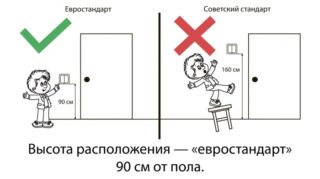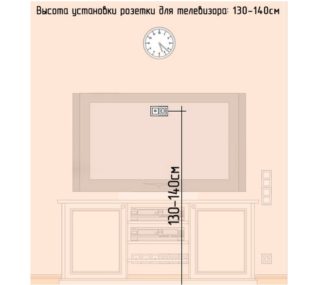For the safe and convenient use of electrical appliances and control of light sources, stationary power points are installed in the apartment. The location of sockets and switches in the apartment is chosen from the point of view of ease of use, but technical installation rules must also be taken into account.
Circuit breaker placement rules
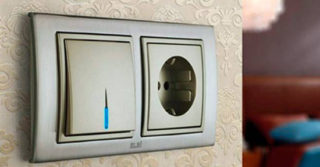
There are two standards for the placement of switches and each has its own advantages:
- Soviet. Sockets are installed at a height of 90 cm from the floor, switches - 1.5-1.6 m. In this case, small children do not reach the device with their hands, therefore they are safe. At the same time, adults do not have to bend down to plug the equipment into the outlet.
- Eurostandard. Sockets - at the level of 30 cm from the floor, switches - at a height of 90 cm from the floor. Electrical points are not conspicuous, often hidden by furniture. The switches are accessible even to children, and adults do not need to raise their hand to turn on the light.
When choosing switches, you should be aware that electrical appliances of this kind have different degrees of moisture protection. For damp rooms, you need to purchase a device with protection against penetration and ingress of moisture, or take it out of the room.
Planning the placement of outlets
In order to understand in detail the placement of outlets in an apartment, before the direct installation of electrical devices, it is necessary to draw up a plan taking into account the amount of equipment. First of all, they draw up a diagram of the apartment, noting the location of furniture and technical devices. Moreover, the number of electrical outlets is increased by one or two units, providing for a possible expansion of the arsenal of household appliances used.
In addition to technical requirements, they take into account how convenient it will be to use the connector, whether it is invisible or striking and spoils the interior.
Electrical appliances are placed on the side of the door handle, and not on the hinges, since in the latter case you will have to bypass the canvas to use them.
Layout scheme
If the plan of sockets and switches is drawn up for builders, it is mandatory to make it on a scale on graph paper with reference to the general layout. The locations and installation heights of the devices are indicated in accordance with the standards.

The layout of the electrical wiring elements must be agreed with the designer.
How to determine the required amount
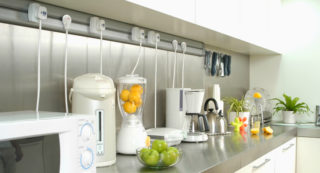
How many sockets should be in an apartment depends on its equipment with household appliances. Experts advise to provide a separate plug for each electrical device, located in a place convenient for its use. Moreover, in each room, you should also add a couple of electrical outlets with a view to the future. A detailed plan is a good help in determining the number of electrical appliances.
Features of the placement of sockets
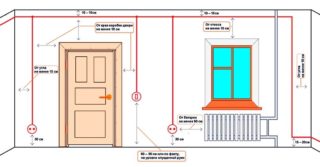
When detailing the installation plan, it should be clarified that special rules are imposed on the placement of outlets in an apartment, which are of a recommendatory nature, reflected in the "Code of standards for construction and design", as well as in SNiP 31-110-2003:
- The height of the switch is determined taking into account the average height of family members so that everyone can use it without raising their hands. On average, this figure is 80-90 cm from the floor surface.
- The switch should be located on the side of the door handle, in the immediate vicinity of the doorway, about 10-15 cm from it.
- Electrical connectors should not be covered by pieces of furniture, which impairs access to them and the outflow of heat.
- Switches for the bathroom and toilet are taken out into the corridor.
They take into account the recommendations of the designer and the nuances of the design project.
Accommodation rules in various residential areas
Each room is equipped with electrical appliances that are different for their purpose, and their number also varies. When drawing up a plan for the location of electrical points, it is important to take into account the characteristics of the room. The provisions on the correct location of sockets and switches in the apartment are fixed in the regulatory documents: SNiP, PUE, GOST.
Kitchen
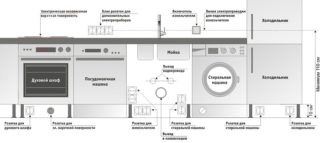
In order to correctly determine the location of all electrical points, it is necessary to plan where exactly household appliances will be located. Since small and large household appliances are installed in the kitchen, it is important that there are as many outlets as there are devices, and better with a margin. They should be conveniently located so you don't have to use extension cords or tees.
First of all, they think over the location of sockets and switches for stationary household appliances:
- refrigerator;
- washing machine;
- hoods;
- waste grinder;
- dishwashers;
- built-in microwave;
- electric oven and hob;
- water leakage sensor;
- ceiling and built-in lighting fixtures.
The hob connector is conveniently located on the side, in a cabinet with a hinged door, or in a skirting board. Moreover, some models are connected directly to the wire, and not to the outlet. Therefore, a separate connector may not be required.
It is recommended to install the refrigerator socket under the refrigerator, but this can be inconvenient if you have to defrost it frequently. It is better to install the connector to the right, to the left of it, or from the top.
To connect non-stationary appliances, you need sockets on the apron, two sockets on the left and right sides of the kitchen. Convenient when one or two sockets are located next to the dining table. It is important to provide that small household appliances can be connected to the network at the same time.

You will need to organize access to the power supply for the TV, if it is a model with the SMART function, you need an Internet outlet. It is recommended to install the connector for the vacuum cleaner at a level of 30-40 cm from the floor, next to the entrance to the kitchen. The optimal place to install a kitchen light switch is 75-90 cm from the floor and 10-15 cm from the doorway.
At the same time, they adhere to some requirements:
- It is forbidden to place the socket behind household appliances. It should be installed side by side, behind the wall of an adjacent cabinet or in a baseboard.
- Connectors for the hood and TV are mounted at a height of 2-2.5 cm from the floor, that is, above the hood and behind the TV panel.
- Outlets for small appliances should be at a height of 10-30 cm from the table top, and the lower edge should be at least 5 cm from it.
- Two separate sockets are made for the hob and oven, since the double outlet will not withstand the load.
Sockets located in the immediate vicinity of a water source must be of a high degree of moisture protection. This applies to connectors for a shredder, washing machine and dishwasher.
Living room
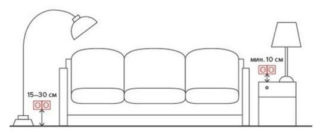
In the living room, the switch should be located by the door at a height of 75-90 cm so that it is accessible to all family members.An outlet is also located there, for example, it can be used to connect a vacuum cleaner. About 10 cm recede from the doorway, and 30 cm from the floor. If the room is large, another outlet will be required for the vacuum cleaner - at the far end of the hall.
It is also necessary to install several outlets in the area where the TV is located. You will need connectors for connecting a TV, DVD-player, audio system, Internet socket. Placement height - 130 cm. They will be covered by the TV panel, but free access will be organized to them.
At the sofa, you should make sockets for wall lamps, a floor lamp, a laptop, a telephone. In addition, depending on the location, electrical points for air conditioning and additional equipment should be planned. It is advisable to make electrical outlets next to the seats.
If a working table is installed in the living room, you need connectors for a desk lamp, computer, monitor, speakers, printer, scanner. It is better to place them above the table so that it is convenient to turn on / off devices.
If there is an aquarium in the living room, connectors for filter and lighting are required.
Bedroom
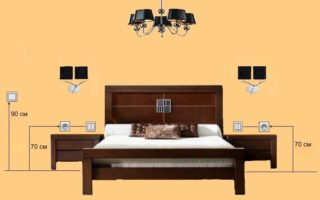
In the bedroom, you will need an outlet block next to the bedside tables to put the phone on charge, connect a laptop, tablet, e-book. Further recommendations depend on which appliances are installed in the bedroom or which zones complement the space. This could be a work area or a TV. A switch and a socket for a vacuum cleaner are placed at the door as standard. You may also need electrical outlets for additional lighting sources.
Bathroom
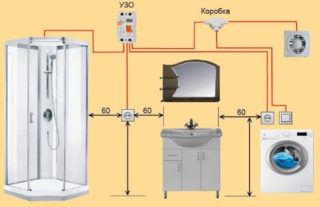
The location and number of outlets in the bathroom is determined by the electrical appliances connected to them. Almost always here you need electrical points for a washing machine, hair dryer, electric shaver. In addition, you may need connectors for a water heater, heated towel rail, dryer.
Correct location of outlets in the bathroom - at least 60 cm from the floor and the water source. Moreover, these should be special devices with a high degree of moisture protection.
Hallway
In the hallway, it is convenient to place an outlet and a switch next to the entrance so as not to walk through the entire room in dirty shoes to turn off or turn on the light. The socket can be installed under the switch - for a vacuum cleaner, for example, or a shoe dryer, a doorbell.
Children
Cabinet
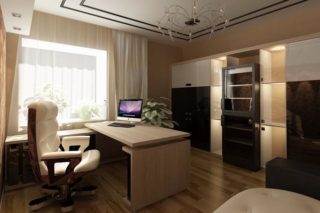
The home office should also be equipped with a sufficient number of electrical outlets and switches. Without fail, you will need a block of outlets at the desktop. They can be installed 15-20 cm above the table top or hidden behind the table, at a level of 20-30 cm from the floor. The office can be installed:
- desktop light source;
- stationary computer;
- monitor;
- columns;
- Printer;
- scanner;
- copier;
- notebook;
- phone charger;
- aquarium;
- television.
All of these devices require their own power outlet as they can be used simultaneously. It is also recommended to provide a connector for a vacuum cleaner.
If in a new building the location of sockets and switches more or less meets modern requirements, then in apartment buildings built 25 or more years ago, the number of electrical points is very limited. In any case, when planning, it is recommended to build on individual wishes and take into account the standards.

